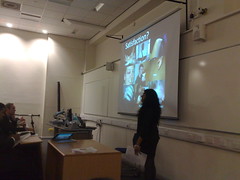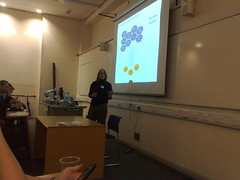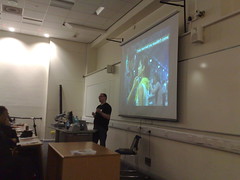Getting Certified
January 20, 2009 | CommentsI've just finished a 2-day training course with Mike Cohn, with the grandiose title of "Certified Scrum Master". It covers a basic introduction to Scrum, and details of how to implement the process into a company: roles, responsibilities, processes, etc. The format was very participative, with Mike setting frequent exercises that demonstrate aspects of self-organisation or collaboration, and got us thinking about issues which might affect Scrum teams.
We've been using Scrum for over a year now and I've been grokking this agile stuff personally since 2004, so I was pretty confident with the introductory side of things - but still came away with a load of tips, ideas and practices from Mike which I'm looking forward to trying out. I'm also thinking of trying to divorce our release planning from sprint planning a bit more - doing broad estimates for the former in story points, and finer-grained task estimates during sprint planning in hours.
All very interesting stuff, and particularly good to have a range of folks in the class: from different types of companies (startups to the QA departments of banks), with different levels of expertise and clearly different perspectives and needs. Our table exchanged cards at the end of the two days, it'll be interesting to see how much of a support group we can provide for one another when we take what we've learned home :)
Next stop for me is the follow-on qualification, Certified Scrum Practitioner. I'm actually ambivalent of the value of CSM myself, as it doesn't involve much in the way of tests or practice. It gives a great grounding, but I think that (as with so many things) the only chance to learn this stuff is by doing. But the CSP qualification involves having a years experience and being able to write cogently about real-world application of Scrum - something I feel able to do on paper as well as on this site :) As a small business, sometimes we talk to people who want reassurance of our ability to deliver; perhaps a certification of some sort can help here. Plus CSP seems to be a slightly more exclusive club - I counted about 35,000 registered CSMs on the Scrum Alliance site, but only 500 or so CSPs worldwide.
If you get a chance, I thoroughly recommend getting to one of Mike's courses.
Mobile Persuasion, City University
January 19, 2009 | CommentsIntro from the head of the HCI department at the University, talking about facilities they have available for rent. Interesting, I hear a lot about this from Sussex folks too - universities finding a new role for themselves in the world of commerce, perhaps?
Introduction, Scott Weiss
Does a poll of the audience - mainly designers, with a smattering of developers and other folks.
We don't have the same attachment to our mobile devices as we do to other products we manufacture. Take BMW, and the promise of "sheer driving pleasure".
Different car brands conjure up different images and strong brand associations - and people associate themselves with different car brands (e.g. Prius, Jeep). What about phones?
Most mobiles have a screen, keypad, make calls, check email: simple, consistent, usable. But they're getting more complex: give up some simplicity in exchange for more features (e.g. N95). Consistency, simplicity and usability lead to predictability and boredom.
References the example of hand dryers - show traditional model and a much more modern one. Bryan apparently looks for toilets with these dryers now. Very suspect.
Small things can make a big difference. References Slumdog Millionaire, which makes excellent use of subtitles with different fonts, backgrounds and colours.
Persuasion is communicating a message to affect belief or action.
Think of the "average music phone", a young man (talks about persona, a 20something from Manchester); a working mum (30something, into Abba, lives in London); and older gentleman (50something divorcee from Bristol). Most music phones let you listen to and maybe purchase music, measured in tracks they store, features. What other messages are here? Availability of content, quality of headphones, weird jacks, etc. Matching these messages up to our own lives often leads to disappointment.
These messages should inspire and build trust. Everything a phone says will be weighed one way or the other.
How do you inspire people? What will the device let people do? Deliver on your promise, or destroy trust with FUD.
So, the status quo: a consistent, usable device. Nokia will launch the 5800 xpress in the UK in two weeks. Is it that different? Is the plectrum brilliant, or pointless differentiation? Plectra: good for guitars. Good for Guitar Hero. The 5800 isn't that different, it's your dads phone in a different suit. The iPhone is different: one device is all about you, even ocarinists (sp?).
What if you could wrap 2 turntables and a mixer into the device? (oops... Barley alert!)
Shows photo of old tear-shaped Nokia, which would've made a nice ocarina.
Gimmicks aren't enough - you need to continue to deliver day after day. "The long wow".
Give me freedom to love your product. Make the easy decisions for me. Don't make me look or feel stupid. It's about control.
Language: don't ignore all the little details. You wouldn't talk to people the way apps talk to you.
Craftmanship: push for beyond the acceptance criteria and usability requirements "to make things of such obvious superior quality as to overcome the advantages of the machine".
Q: Bryan, your thesis is that mobile phones are consistent, it's all being done, what next? I'm reminded of a story from the terror attacks in November: a man called his daughter, made it to where she worked, and when his phone rang it gave away his position. He was killed. The design community have missed making functions accessible.
Q: What's different here between design and persuasive design?
A: I don't know.
Q: Will devices lead this change, or services?
A: Devices first, they'll lead the overall UE.
Q: What was the last mobile device that excited you and why?
A: iPhone, and 6630 before that (thanks to the weight)
Q: Why is the Apple brand persuasive and Nokia not.
A: It's a tradeoff; the ease-of-use I get with iPhone vs my beloved Nokia devices. iPhone has faults but has a better experience overall.
Priya Prakash, Head of Product, Flirtomatic
Going to talk about the crafting of persuasion. Flirting is quite relevant here.
What is persuasion? It's all about context. Obama became more persuasive over time. Tells a story of Obama sending a personal email to a supported 20m before going to make his acceptance speech: timing meant a lot.
References iPhone/Obama app: use of phone book to contact friends: encouraged action.
Like Bryan, I'm not sure what mobile persuasion is. No such thing.
 Why do people buy iPhone? There's lots of social engineering in the background. Look at Apples product roadmap: moving into areas where technology has been tested and failed, and sorting it out with good timing.
Why do people buy iPhone? There's lots of social engineering in the background. Look at Apples product roadmap: moving into areas where technology has been tested and failed, and sorting it out with good timing.
References "I am Rich" app. All it did was demonstrate wealth. Wired ran a story about a kid who hacked into it, so others could download it illegally and ask for a refund.
Satisfaction: www.wiiinjury.com, a site full of happy Wii owners bleeding. This is BEYOND USABILITY: public demonstrations of injury.
Flirtomatic did an iPhone app, put it in front of O2 customers and tried to see if anyone found it. Someone on the forums was already asking for recommendations of apps - browsing the store is already too cumbersome.
New phones create new behaviours. "When you design a car, you design a car accident". Every time we create a new feature, we try and see how we can tap into existing behaviours.
References article from BBC today re phone features baffling users.
Priya gets us trying to text from our neighbours phones. Even within a group of mobile professionals, there's a lot of disparity in ability to actually use.
Flirtomatic have done very well at creating "the funnel": at each touchpoint, there's a trigger, a call to action, the user has done something. Flirto are aggressive at removing the barriers to further use. Tangent: we need new mobile ad formats. Language is important. Registration is the act of finding someone, and contains minimal form fields. Users are considered active when they send their first Flirtogram. When a user becomes active, we help them to flirt better using value-added services: sales of virtual goods. You can throw a pair of knickers at someone easily. Flirtomatic is about killing time: "there's no better USP than 'I am bored'".
They turn emotional goals into actionable statements. e.g. the Flirtbomb. We are 60/40 male/female. Most guys are tongue-tied and crap at flirting - most women know this. Flirtbombs hit lots of flirts at the same time with the same line - a conversational carpet bomb (my words, not Priyas).
Principle 2: Action palette. Keep trigger-design: minimal, consistent but widely recognisable. Ratings become important, so users pay to delete bad ratings.
Principle 3: Easy sampling, design for easy trialling of a service. The act of searching is a registration. It's all about harmless fun, the registration reflects this.
Principle 4: make benefits socially meaningful to the user's context. The brand is about being cheeky, naughty, funny - we don't take ourselves too seriously. We ran a leap year proposal on February 29th, sold more rings than anyone else in the UK. In the run up to Summer we sold virtual boob jobs and six-packs in a "get in shape" promotion.
Principle 5: monitor usage to tweak access points. Every day I get a VAS report, a morning traffic report, and a payment report. It's about seeing how well we can keep the service singing: not just about features. Every day we're looking to see how we can tweak figures to improve usability. We have very socially and technically aware users.
What else works? Skype installs triggers to make any number clickable. Orange Wednesdays.
 Kath Straub, Human Factors International
Kath Straub, Human Factors International
We're thinking about you can take the design you have and handle the things that stop me engaging more.
As an organisation, once you have me engaged you need to persuade me: once you've persuaded me, you've got me.
e.g. US pharma sites have "doctor discussion guides", encouraging you to discuss drugs with your doctor with a view to getting them to prescribe them. Now I'm helping you to take the decisions consistent with my business model.
Drivers and barriers for mobile adoption: more stuff to learn, security, easier to do on PC, cost, hard to see, etc.
20somethings get the idea of gestural UI, older folks - even the tech-savvy - don't.
When we shift activities to mobile, we're shifting them from the PC to the mobile space. Lots of folks aren't ready for this. Persuasive design means different things to different groups.
Palm: "a heavy thing that fit beautifully in a man's shirt pocket".
Old markets started out with a teller, then moved to ATMs (which were painful initially). Security concerns: if my transaction stops in the middle, did I pay my bill or not?
References American bank that uses a mobile phone for identity, building an association between "mobile" and "security". Now I am the kind of person who does stuff on my phone: a block has been removed through a social psychology principle (momentum), and now I'm ready for the next step.
Elsewhere, Bank of America has emphasised cross-platform consistency so the interface on my ATM is almost identical to the interface on my desktop, or on the phone - removing the fear in traversing these spaces. We won't to find out why people *don't* flirt online - maybe they're scared no-one will flirt back? If someone flirts with me I feel a responsibility to flirt back (reciprocity).
Another difficult thing: reading text on mobile. When I read I have to traverse the line and return to the beginning of the next line. If the end of the line ends mid-phrase I have to keep in mind what was happening on that line. This is computationally intensive for us.
Shows ReadSmart - a way of formatting text to make it easier to understand what it means, by putting pauses in the right places. Charities sending out letters formatted like this get more donations and better response.
In the US, there's excitement about geolocation traded off with fear of security (where I am, that I'm not home). iPhone only lets you run one app at a time - stopping third-party-tracking-me apps.
We're seeing an uptake in mobile social networking with older individuals in Facebook - connecting older generations with kids and grandkids. Weird spike, with a gap in the middle populated by the baby boomers.
Video is the hot app in mobile markets (US anyhow).
Devices are the barrier to entry, but it's all about the apps. The device is receding into the background; design has made this possible, but that's not the persuasive piece.
Q: How does persuasion affect user research?
A: In traditional usability research, we're thinking about "can they do this task". In persuasion we're thinking about motivations.
Battery low, so that's the end of my notes...
Design-related titbits
January 18, 2009 | Comments- Phil Gyford has some nice ideas on digitally representing books;
- Transcript of an interesting conversation between Alan Cooper and Kent Beck: Extreme Programming vs Interaction Design. In particular I had a minor "aha" moment understanding Alan when I read that he's "advocating interaction design, which is much more akin to requirements planning than it is to interface design". I'd always seen it as much more interface- than requirements- related;
- The Kano model; nothing new, but nice to read it;
- Putting the fun into functional, a lovely slideshow on taking lessons learned from gaming and applying them to (predominately social) software;
- Another piece, an interview this time on game mechanics for interaction design;
- Bryan has a characteristically excellent article on effective design for multiple screen sizes;
- Whitney Hess on what user experience design isn't: +1, +1, +1;
- The importance of control in product design: "Give me control, and I will love your product. It's as simple as that."
- Will less popular languages suffer from limited support via predictive text?
- Apple is patenting more touch-screen goodness, this time swipe gestures. I'm presuming Palm are doing the same :(
Palm Pre
January 17, 2009 | CommentsAllow me to join the throng of people punching the air with delight on the news of Palms upcoming return. I was a loyal Pilot and Vx user long before I got the mobile bug, and still have happy memories of the platform... and as it happened, the very first project that FP delivered was a native Palm application. The Palm story is one of my favourites, too: a small team (7 people I believe), laser-like focus on user experience, delivering a great product that went against conventional wisdom of the time: remember that handhelds post-Newton and post-Go were considered tried-and-failed. Check out Designing Interactions for a good couple of interviews with Hawkins and Haitani.
So, the Pre interests me for lots of personal reasons, let alone fact that it's demonstrably possible, post-iPhone, for someone to launch an entirely new platform and put a new and strong-looking competitor into the market. Sure, a new platform - particularly a decent one - once more exaggerates the problems of fragmentation that plague mobile, but it seems churlish to complain about a device that seems to deliver fresh thinking, decently executed.
So, some links and commentary:
- Video of a couple of walkthroughs, universal search, a hardware hands-on, "Synergy" (unified messaging and multitasking), WebOS UI (love the gestural stuff there), and the first presentation and demo
- A hands-on review with lots of photos;
- Initial pricing appears to be low - $149?
- Palm are "definitely interesting", "simply amazing", and have "made a splash"
- Palm WebOS won't be backwards compatible, but really, who cares?
- The developer site already talks of an application framework built on web technologies, deep handset integration via JSON, and the now-obligatory on-device application store (though not with games as a priority, apparently).
And is it my imagination, or is the name Pre, and much of the marketing going along with it, a weird homage to Jeff Hawkins' (founder of Palm v1) theories on the predictive nature of our brains?
In case you cared...
January 01, 2009 | Comments...my two favourite web services:
- PhotoJoJo's Time Capsule, which emails me monthly with a few (random) pictures from my Flickr, but a year ago. I really look forward to these little enforced walks down memory lane.
- Doodle, a beautifully simple meeting-arranger/decision-marker app. No sign-up, no frills, no advertising, but does what it does to perfection.
